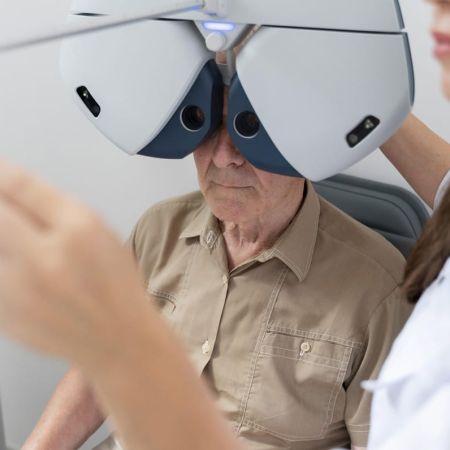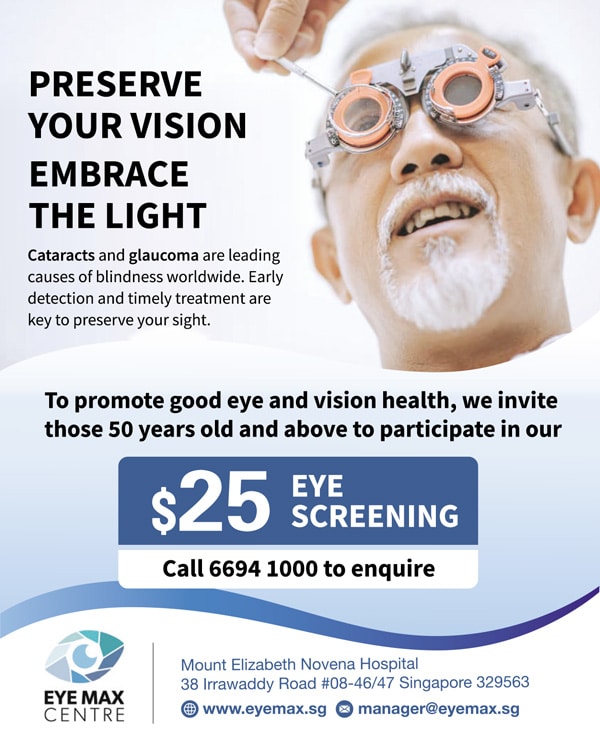Unveiling clouded vision: Understanding the Risk Factors of Cataracts
Cataract is one of the commonest eye diseases that start to occur from the age of 45. In this article, we will discuss some factors including ageing, genetics, UV exposure, diabetes, smoking, eye trauma and other health conditions that contribute to the formation of cataracts.
Ageing – As we age, the proteins on the eye’s natural lens start to disintegrate and cluster together resulting in vision being foggy and cloudy. Over time, the continued fogginess and cloudiness will impair vision causing blurriness.
In rare instances, cataracts can be congenital when the lens of the eye is cloudy at birth instead of clear, making it hard to see. This type of cataract can form in one or both eyes and is usually genetic.
Ultraviolet (UV) radiation – Our eyes can absorb a high percentage of UV radiation exposed to us. Studies have shown that extended exposure to UV radiation can damage the eyes. Prolonged exposure to UV radiation contributes to 10% of the population for cortical cataracts (the peripheral area of the eye lens experiences cloudiness). According to World Health Organization (WHO), ‘it is estimated that 15 million people are blind due to cataracts; some 10% of these may be due to exposure to UV radiation.’

According to World Health Organization (WHO), ‘it is estimated that 15 million people are blind due to cataracts; some 10% of these may be due to exposure to UV radiation.’
Systemically chronic conditions such as diabetes can cause an earlier onset of cataracts. High glucose levels in diabetic individuals can cause structural eye changes which hastens cataract formation. Several clinical studies have shown that the development of cataracts is more commonly seen in those with diabetes. Some common types of cataracts seen in Type 1 diabetic individuals are senile cataract (age-related), posterior subscapular cataract (starts small and opaque area usually near the back of the lens, right in the path of light) and snowflake cataract (grey-white subcapsular opacities).
Smoking can also cause cataracts to develop more rapidly. Whether it is tobacco or e-cigarettes, smokers are more prone to acquire cataracts quicker than non-smokers. According to WHO, smoking may increase the creation of free radicals, which damage DNA resulting in cataracts. On the other hand, e-cigarettes may cause decreased blood flow to the eyes and changes to retinal function. This subjects smokers to a higher chance of developing eye cancer.
Trauma can also cause the eye’s natural lens to turn cloudy. This occurs when trauma to the eye disrupts and destroys the lens fibres, either bluntly or penetratingly. The majority of traumatic cataracts result in swollen eye lenses. In 24% of individuals with global contusions worldwide, traumatic cataracts develop. These cataracts can develop from contusive eye injuries either right away or years later.
Traumatic cataracts can be grouped into a few types listed below:
Blunt trauma happens when the eyes are hit or bumped into an object, however, there is no cut or penetration. For example, when a tennis ball hits the eye causing damage.
Penetrating trauma happens when sharp items such as a sharp metal object, sharp stick or even a pen puncture the eye. A traumatic cataract should be anticipated immediately if the sharp item passes through the cornea and into the lens. A complete rupture and lens damage are also possible. Blindness and partial or complete cataracts are potential outcomes.
Chemical trauma happens when a chemical substance enters the eye and alters the composition of the lens fibres which causes traumatic cataracts.
Radiation trauma – happens when one is exposed to radiation. The time between radiation exposure and contact and cataract formation though can be rather long.
Those with rheumatoid arthritis, an autoimmune condition, Marfan syndrome and chronic malnutrition may experience an early onset of cataracts. Same for those with atopic dermatitis and asthma who require prolonged use of steroid medications.
Understanding Cost for Cataract Surgery in Singapore
The only effective and proven way to treat cataract is to consider cataract surgery. Cataract surgery costs in Singapore can range from $7,000 to $12,000 or more for each eye. The final cost is dependent on a few factors including type of intraocular lens used, complexity of surgery, cataract surgeon’s experience and expertise, type of anaesthesia used and location of surgery. Cataract surgery in Singapore though is both insurance- and Medisave-claimable (up to $2,450 per eye) with the latter only applicable for Singapore citizens and Permanent Residents.
Visit Eye Max Centre Singapore for your cataract screening. If you are experiencing cataract-related issues, contact us at +65 6694 1000 or manager@eyemax.sg to schedule an assessment with our cataract surgeon.

References:
https://www.ncbi.nlm.nih.gov/pmc/articles/PMC3061107/
https://www.who.int/news-room/fact-sheets/detail/ultraviolet-radiation
https://www.hopkinsmedicine.org/news/articles/how-to-protect-your-eyes-from-uv-damage…
https://www.ncbi.nlm.nih.gov/pmc/articles/PMC6422859…
https://pubmed.ncbi.nlm.nih.gov/4058882/
https://www.who.int/news/item/20-10-2022-smoking-linked-to-early-vision-loss-and-cataracts
https://www.aao.org/eyenet/article/management-of-traumatic-cataract
https://www.sciencedirect.com/topics/medicine-and-dentistry/traumatic-cataract
https://www.allaboutvision.com/conditions/cataracts/faq-traumatic-cataract/
https://erj.ersjournals.com/content/27/6/1168…

